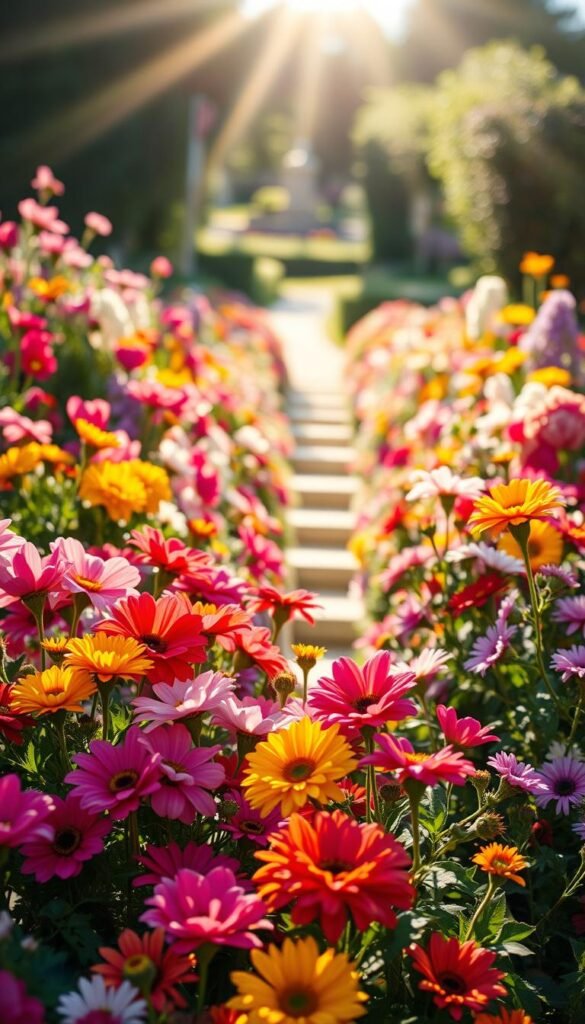Imagine stepping outside to gather fresh blooms whenever you want to brighten your home. A dedicated growing space designed for cutting lets you create vibrant bouquets from spring through fall. You’ll enjoy continuous harvests by understanding how different plants work together in professional floral designs.
Every stunning arrangement uses five key elements: bold focals, vertical spikes, round discs, delicate fillers, and wispy airy bits. By growing varieties from each group, your bouquets will look balanced and intentional. Start by testing your soil’s texture and nutrients – healthy roots mean stronger stems and longer-lasting blooms.
Smart design keeps your space productive. Place tall sunflowers behind mid-height zinnias, with trailing sweet peas along borders. This layered approach maximizes every square foot while creating visual interest. You’ll learn which varieties thrive in your region and how to stagger plantings for nonstop color.
With thoughtful preparation, your outdoor space becomes a personal flower shop. Fresh dahlias for summer centerpieces, frost-resistant pansies for autumn vases – the possibilities grow with each season. Ready to dig into the details?
Introduction to Your Year-Round Cut Flower Garden
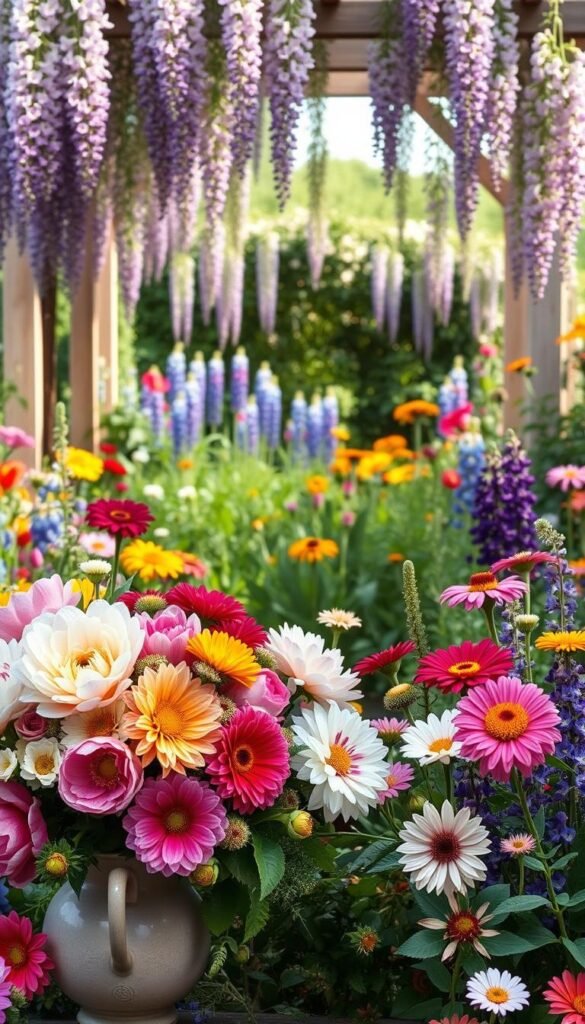
Transform your outdoor space into a living bouquet that changes with the months. A dedicated cutting area lets you harvest fresh blooms for vases while keeping plants thriving season after season. Unlike traditional beds, this setup prioritizes stem production and bloom longevity – perfect for creating arrangements that last.
Imagine the satisfaction of filling mason jars with tulips in April, sunflowers in July, and asters in October. You’ll discover how different textures and heights work together. For example:
- Snapdragons add vertical drama
- Cosmos bring feathery movement
- Zinnias offer bold color saturation
Your space becomes a habitat for butterflies and bees while serving as a personal design studio. Early risers might clip dewy roses before breakfast, while evening gardeners can gather fragrant stock at dusk. This year-round approach means you’re never more than a few steps from nature’s artistry.
Beyond aesthetics, you’re cultivating resilience. Rotating crops and planting successive varieties ensures continuous harvests. Cool-season pansies give way to heat-loving celosia, followed by frost-tolerant chrysanthemums. Each season brings new opportunities to experiment with color palettes and floral combinations.
Understanding the Basics of a Cut Flower Garden
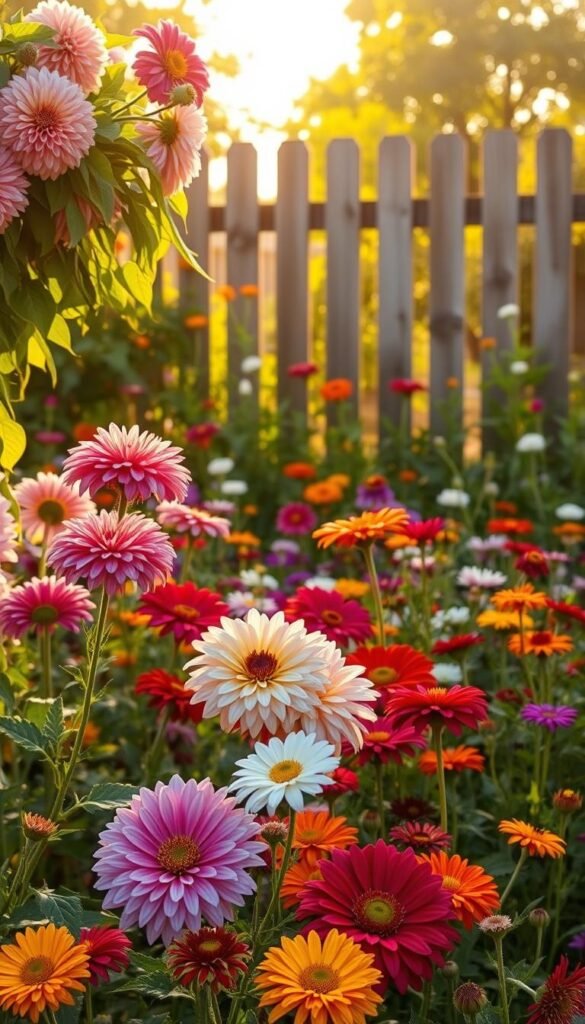
Have you ever wanted endless fresh blooms at your fingertips? Unlike decorative beds meant for curb appeal, these spaces prioritize harvest-ready stems and repeat flowering. Think of it as your personal floral workshop – every plant serves a purpose in creating stunning displays.
What Makes These Spaces Unique?
Traditional gardens focus on visual impact outdoors, but your cutting-focused plot works like a renewable resource. You’ll grow mainly annuals like zinnias and cosmos that pump out blossoms all summer. A few perennials like lavender add structure, while foliage plants like dusty miller provide textural contrast in arrangements.
Why Grow Your Own Blooms?
Store-bought bouquets often come with hidden costs – price tags, chemical treatments, and limited variety. When you nurture plants yourself:
- You control bloom timing for peak freshness
- Unusual varieties become accessible (try chocolate cosmos!)
- Stems last longer since they’re cut at ideal maturity
Morning harvests become a ritual – snip dewy peonies as birds chirp, or gather sunset-hued dahlias after work. Your vases stay overflowing while supporting pollinators like swallowtail butterflies. It’s sustainability and beauty combined, one stem at a time.
Evaluating Your Garden’s Location and Soil Quality
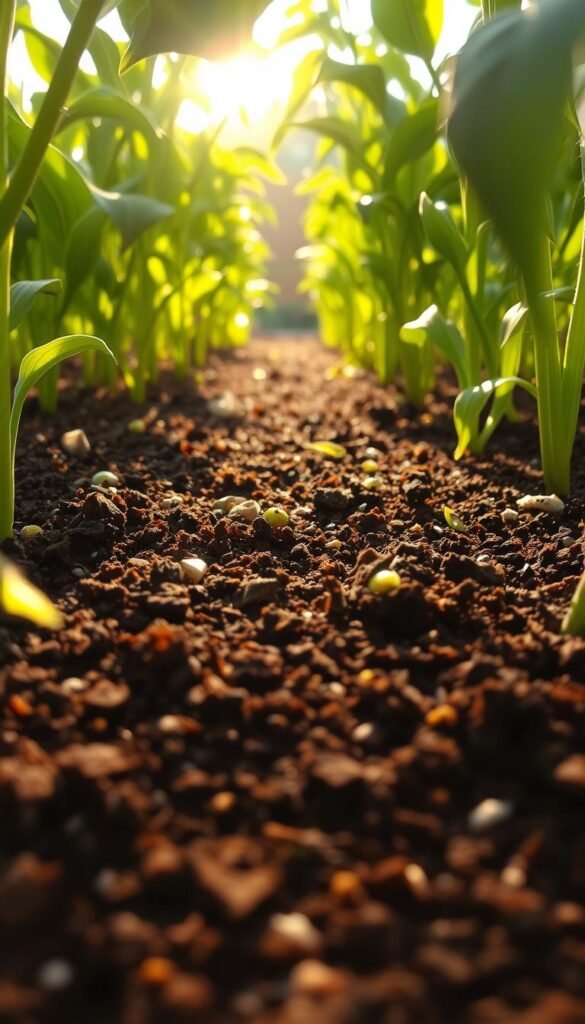
Where’s the sweet spot in your yard that could become a bloom factory? The right combination of sun exposure and healthy earth determines whether your plants thrive or merely survive. Let’s break down how to set up your growing space for success.
Sunlight Patterns Matter
You’ll want to check three times daily—morning, noon, and afternoon. Does your chosen area get six hours of direct sun? Shade from trees or buildings can reduce bloom counts by 40% in some varieties.
Track shadows over a week. South-facing spaces often work best, but don’t ignore microclimates. A spot near a white fence might reflect extra light, while low areas could trap cold air.
Digging Into Dirt Details
Healthy soil feels crumbly and smells earthy. Squeeze a handful—if it stays clumped, add compost. A $15 test kit reveals pH and nutrients. Most flowers prefer slightly acidic soil (6.0–6.5 pH).
Amend beds each spring with organic matter. Try this mix:
- 2 inches of compost for texture
- Balanced fertilizer for nutrients
- Mulched leaves for winter protection
Well-draining soil prevents root rot. If puddles linger after rain, build raised beds. Your flowers will reward you with stronger stems and brighter colors.
Planning a Cut Flower Garden for Year-Round Arrangements
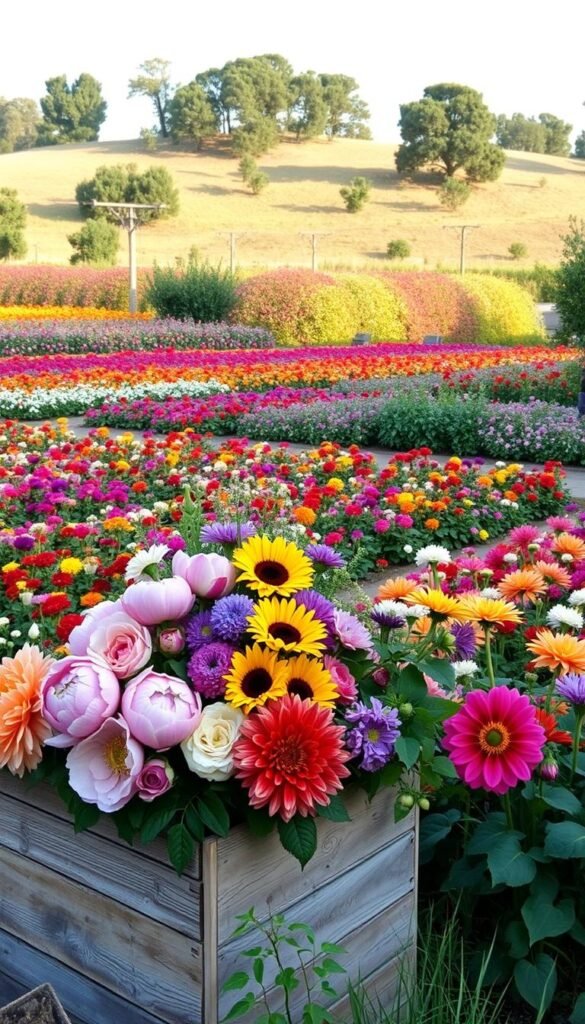
Crafting a continuous supply of fresh blooms starts with smart selection. Think like a floral conductor, orchestrating plants that perform in nature’s rotating seasons. Early-blooming sweet peas give way to summer’s zinnias, while autumn asters take center stage as temperatures drop.
Prioritize plants with varying bloom times and complementary shapes. Towering snapdragons pair beautifully with mounded calendula, creating dynamic contrasts in arrangements. Fragrant stock adds sensory appeal, while cosmos’ wispy stems bring movement to bouquets.
Here’s what matters most when curating your lineup:
- Peak flowering periods that fill seasonal gaps
- Stem strength and longevity in vases
- Color harmonies that evolve through months
Try interplanting quick-growing annuals between perennials. Sow new batches of bachelor’s buttons every 14 days for six weeks straight – you’ll triple your harvest window. This staggered approach keeps clippers busy from first thaw to frost.
Remember to mix roles within your plant roster. Bold dahlias anchor displays, while feverfew’s delicate clusters soften edges. Including textural elements like ornamental grasses ensures every arrangement feels complete and professional.
Choosing the Perfect Flower Varieties for Your Climate
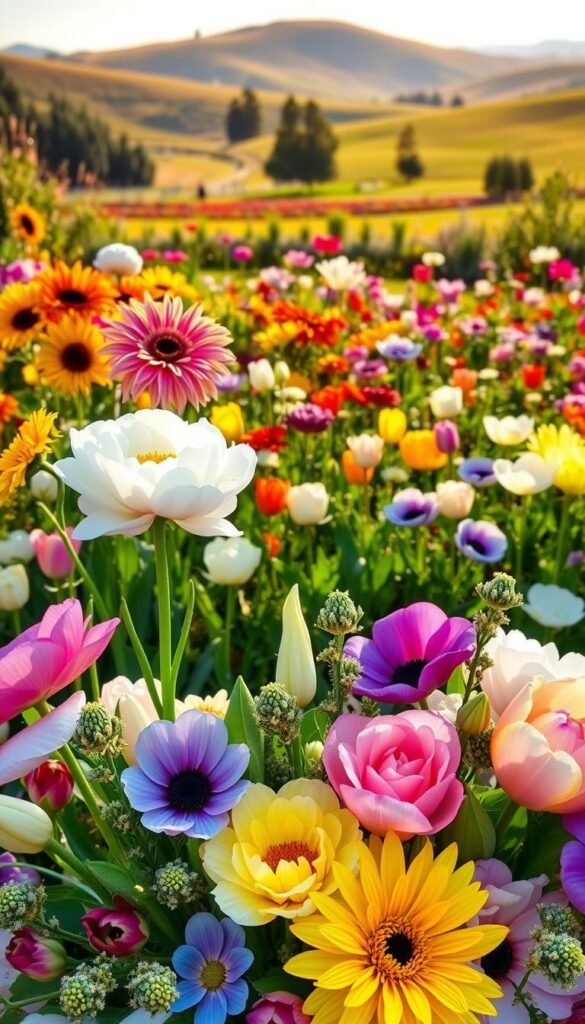
What grows best in your backyard bloom factory? Successful selections balance seasonal performance with your local weather patterns. Professional growers use five key roles in arrangements – bold focals, vertical spikes, round discs, supporting fillers, and wispy accents. Matching these to your growing zone ensures endless vase-ready stems.
Seasonal Stars Through the Calendar
Spring starts with cool-weather champions. Plant tulip bulbs in fall for early focal blooms, pairing them with snapdragon spikes and poppy discs. Add feathery bachelor’s buttons for texture – their blue hues pop against daffodil yellows.
Summer demands heat warriors. Zinnias become color-packed focal points while celosia adds flaming spikes. Cosmos discs float above minty filler herbs, creating bouquets that handle July’s scorch. Water deeply but less frequently to encourage strong roots.
Fall calls for durable performers. Chrysanthemums shine as frost-resistant focals, while strawflowers keep their disc shapes even when dried. Continue harvesting salvia spikes until first freeze – their purple plumes pair beautifully with golden marigolds.
Building Balanced Bouquet Ingredients
Think like a floral chef mixing textures. Start with 3-5 focal blooms as your “main course.” Add 5-7 vertical spikes for height, then scatter disc-shaped flowers between them. Fill gaps with clusters of smaller blossoms, finishing with airy stems that catch the light.
Local nurseries often stock climate-adapted varieties. Ask about regional favorites – maybe fire-resistant yarrow for dry areas or mildew-proof zinnias for humid zones. Your garden becomes a custom bloom boutique when plants match your environment’s rhythm.
Designing a Functional and Aesthetic Garden Layout
Creating an inviting outdoor space starts with a smart layout that balances beauty and practicality. Your design should make tending plants effortless while showcasing their natural charm. Begin by mapping zones for different bloom types and maintenance needs.
Sketching Your Garden Plan
Grab graph paper to plot bed shapes and pathways. Mark existing trees or structures that influence sunlight patterns. This cut flower garden design phase helps avoid overcrowding and ensures proper spacing for mature plants.
Creating Focal Points and Defining Borders
Use stone edging or low hedges to frame planting areas. Add vertical interest with arches supporting climbing roses or sweet peas. A central birdbath or bench draws the eye while providing a resting spot to admire your blooms.
| Plant Group | Sunlight Needs | Water Requirements | Height Range |
|---|---|---|---|
| Sun-Loving Flowers | 6+ hours/day | Moderate | 12-36″ |
| Partial Shade Varieties | 3-6 hours/day | Frequent | 6-24″ |
| Drought-Tolerant Blooms | Full sun | Low | 18-48″ |
Keep paths 18″ wide for easy access when watering or harvesting. Cluster plants with matching needs – group thirsty hydrangeas separately from xeriscape-friendly lavender. For more gardening aesthetic tips, consider seasonal color rotations in key beds.
Calculating Space and Planting Distances
Ready to turn measurements into blooms? Proper spacing transforms crowded sprouts into thriving stems. Start by mapping your growing area – even a 4×8 foot bed can yield 50+ stems weekly with smart planning.
Guidelines for Plant Spacing
Give roots room to breathe. Most annuals need 6-8″ between stems – about the width of a dinner plate. Exceptions exist:
- Sunflowers demand 12-18″ for strong stalks
- Sweet peas climb vertically with 4″ spacing
- Marigolds tolerate tighter 4-6″ gaps
Check seed packets for mature widths. Bushy zinnias might need 10-12″, while slender snapdragons thrive at 8″. Overcrowding invites mildew – that powdery enemy of lush growth.
Optimizing Rows and Garden Beds
Arrange plants like puzzle pieces. Try these layouts:
| Bed Type | Row Spacing | Plant Spacing |
|---|---|---|
| Raised Beds | 12″ between | 6-8″ |
| Ground Rows | 15″ between | Variety-specific |
| Container Gardens | N/A | Compact varieties |
Leave 12-15″ walkways for easy access. Stagger plants in offset rows – you’ll fit 15% more stems without sacrificing air flow. Tight spaces? Grow upward with trellised clematis or tall verbena.
Planting Techniques for a Lush Cut Flower Garden
Unlock your soil’s potential by mastering seed-starting strategies. Timing matters—some flowers demand early indoor sprouting, while others flourish when sown directly. Check seed packets for frost dates and germination needs to maximize your harvest.
Direct Sow Versus Starting Indoors
Zinnias and sunflowers thrive when planted straight into warm earth. Their roots establish quickly, creating sturdy stems perfect for bouquets. For cool-season stars like snapdragons, begin indoors 10-12 weeks before spring. A seedling heat mat boosts germination for warmth-lovers like amaranth.
Staking and Supporting Taller Varieties
Install bamboo stakes when plants reach 6″ tall. Weave flower netting horizontally as delphiniums and dahlias grow—this prevents wind damage while allowing light penetration. Tie stems loosely with twine to avoid restricting growth.
Remember: Sweet peas need just 4 weeks indoors, while dusty miller requires patience. Match your approach to each plant’s rhythm, and you’ll enjoy armfuls of blooms from first sprout to final frost.

